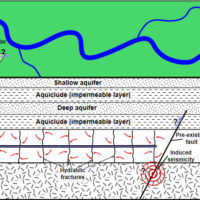Revisiting the Chesapeake Bay
The Effect of Population Growth on America’s Largest Estuary
- Tom Horton
- March 28, 2013
- Forum Papers
- Forum Paper
- 0 Comments
So why do we persist in ignoring a widely acknowledged root cause of pollution like population growth, in light of our failure to clean up the Chesapeake Bay (and many other national environment messes)? Why, despite decades of commissions and studies linking growth and environmental decline, and despite a burgeoning commitment to forging a “sustainable” society, do we keep pursuing growth without limits?
Our excuses fall into three overlapping categories:
• Growth is not the real problem.
• Economic progress requires growth.
• Stopping growth is politically or morally unacceptable.
More growth is not the way to a better, cleaner Chesapeake or planet, according to ecological economists. The reason: a global economy that took all of human history to reach $600 billion a year by 1900 now grows that much every two years. To sustain this current, $16 trillion a year enterprise takes more natural resources than the earth can deliver. Yet the growth plans and aspirations of most nations call for expanding well beyond a doubling.
It might seem the worst time to question growth, in the depths of what many are calling the Great Recession, with unemployment at high levels and stock markets fluctuating erratically. In the short term, government has little choice but to try and boost the economy and get people working again.
But it is also an ideal time for questioning whether the economic growth model conceived more than 60 years ago may have run its useful course; whether its benefits, which we measure and publish in exquisite detail, may no longer outweigh its costs, to nature and to social well-being, which are not nearly so well followed.
Our nation’s elected leaders, citizens, media, businesses, and environmental organizations must come together. We must begin a long overdue debate of these assumptions, to place growth on the radar screen as a critical issue. Our history of trying to restore the Chesapeake has been one of filling in the gaps of pollution – focusing first on sewage and factories, later on the runoff from farms and paved surfaces, and then recognizing the role of dirty air falling on the watershed and realizing the cleansing, filtering value of trees, oysters, and wetlands.
Human numbers and an economy built on their constant expansion is the missing link. Continuing to ignore growth renders most environmental progress in all other areas temporary. It mocks aspirations to live sustainably with the rest of nature, and erodes our quality of life.
Tom Horton covered environmental issues for The Baltimore Sun from 1974 – 2006 and was an educator at the Chesapeake Bay Foundation for five years. He is author of several books about Chesapeake Bay and has written for National Geographic, The New York Times and The Boston Globe. He teaches writing and environmental studies at Salisbury University, and contributes regularly to Chesapeake Bay Magazine and the
Bay Journal News Service . He currently lives in Salisbury, MD, where he is a professor of Environmental Studies at Salisbury University and a contributor to the Bay Journal.

